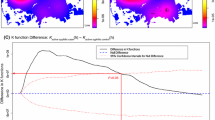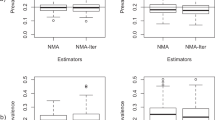Abstract
Respondent-driven sampling (RDS) is a study design used to investigate populations for which a probabilistic sampling frame cannot be efficiently generated. Biases in parameter estimates may result from systematic non-random recruitment within social networks by geography. We investigate the spatial distribution of RDS recruits relative to an inferred social network among heterosexual adults in New York City in 2010. Mean distances between recruitment dyads are compared to those of network dyads to quantify bias. Spatial regression models are then used to assess the impact of spatial structure on risk and prevalence outcomes. In our primary distance metric, network dyads were an average of 1.34 (95 % CI 0.82–1.86) miles farther dispersed than recruitment dyads, suggesting spatial bias. However, there was no evidence that demographic associations with HIV risk or prevalence were spatially confounded. Therefore, while the spatial structure of recruitment may be biased in heterogeneous urban settings, the impact of this bias on estimates of outcome measures appears minimal.

Similar content being viewed by others
References
Heckathorn D. Extensions of respondent-driven sampling: analyzing continuous variables and controlling for differential recruitment. Sociol Methodol. 2007;37(1):151–207.
Magnani R, Sabin K, Saidel T, Heckathorn D. Review of sampling hard-to-reach and hidden populations for HIV surveillance. AIDS. 2005;19(Suppl 2):S67–72.
Des Jarlais DC, Arasteh K, Hagan H, McKnight C, Perlman DC, Friedman SR. Persistence and change in disparities in HIV infection among injection drug users in New York City after large-scale syringe exchange programs. Am J Public Health. 2009;99(Suppl 2):S445–51.
Hathaway AD, Hyshka E, Erickson PG, et al. Whither RDS? An investigation of respondent driven sampling as a method of recruiting mainstream marijuana users. Harm Reduct J. 2010;7:15.
Johnston LG, Malekinejad M, Kendall C, Iuppa IM, Rutherford GW. Implementation challenges to using respondent-driven sampling methodology for HIV biological and behavioral surveillance: field experiences in international settings. AIDS Behav. 2008;12(4 Suppl):S131–41.
Simic M, Johnston LG, Platt L, et al. Exploring barriers to ‘respondent driven sampling’ in sex worker and drug-injecting sex worker populations in Eastern Europe. J Urban Health. 2006;83(6 Suppl):i6–15.
Malekinejad M, Johnston LG, Kendall C, Kerr LR, Rifkin MR, Rutherford GW. Using respondent-driven sampling methodology for HIV biological and behavioral surveillance in international settings: a systematic review. AIDS Behav. 2008;12(4 Suppl):S105–30.
Goel S, Salganik MJ. Assessing respondent-driven sampling. Proc Natl Acad Sci USA. 2010;107(15):6743.
Wejnert C, Heckathorn DD. Web-based network sampling efficiency and efficacy of respondent-driven sampling for online research. Sociol Methods Res. 2008;37(1):105–34.
Rothenberg R, Muth SQ, Malone S, Potterat JJ, Woodhouse DE. Social and geographic distance in HIV risk. Sex Transm Dis. 2005;32(8):506–12.
Toledo L, Codeco CT, Bertoni N, Albuquerque E, Malta M, Bastos FI. Putting respondent-driven sampling on the map: insights from Rio de Janeiro, Brazil. J Acquir Immune Defic Syndr. 2011;57(Suppl 3):S136–43.
McCreesh N, Frost SDW, Seeley J, et al. Evaluation of respondent-driven sampling. Epidemiology. 2012;23(1):138–47.
McCreesh N, Johnston LG, Copas A, et al. Evaluation of the role of location and distance in recruitment in respondent-driven sampling. Int J Health Geogr. 2011;10:56.
Shepard CW, Gortakowski HW, Nasrallah H, Cutler BH, Begier EM. Using GIS-based density maps of HIV surveillance data to identify previously unrecognized geographic foci of HIV burden in an urban epidemic. Public Health Rep. 2011;126(5):741–9.
Centers for Disease Control and Prevention. HIV infection among heterosexuals at increased risk—United States, 2010. MMWR Morb Mortal Wkly Rep. 2013;62(10):183–8.
Reilly KH, Neaigus A, Jenness SM, Hagan H, Wendel T, Gelpi-Acosta C. High HIV prevalence among low-income, Black Women in New York city with self-reported HIV negative and unknown status. J Womens Health. 2013;22(9):745–54.
Jenness SM, Neaigus A, Murrill CS, Wendel T, Forgione L, Hagan H. Estimated HIV incidence among high-risk heterosexuals in New York City, 2007. J Acquir Immune Defic Syndr. 2011;56(2):193–7.
Bivand RS, Pebesma EJ, Gomez-Rubio V. Applied spatial data analysis with R. New York: Springer; 2008.
Pearl J. Causality: models, reasoning and inference. Cambridge: Cambridge University Press; 2000.
Wood SN. Fast stable restricted maximum likelihood and marginal likelihood estimation of semiparametric generalized linear models. J R Stat Soc Ser B. 2011;73(1):3–36.
Heckathorn D. Respondent-driven sampling: a new approach to the study of hidden populations. Soc Probl. 1997;44:174–99.
Johnston LG, Whitehead S, Simic-Lawson M, Kendall C. Formative research to optimize respondent-driven sampling surveys among hard-to-reach populations in HIV behavioral and biological surveillance: lessons learned from four case studies. AIDS Care. 2010;22(6):784–92.
Salganik MJ. Variance estimation, design effects, and sample size calculations for respondent-driven sampling. J Urban Health. 2006;83(6 Suppl):i98–112.
Ott M, Gile KJ, Uuskula A, Johnston LG. Spatial dependencies in respondent-driven sampling data. Redondo Beach: Sunbelt XXXII; 2012.
Kendall C, Kerr LR, Gondim RC, et al. An empirical comparison of respondent-driven sampling, time location sampling, and snowball sampling for behavioral surveillance in men who have sex with men, Fortaleza, Brazil. AIDS Behav. 2008;12(4 Suppl):S97–104.
Acknowledgments
This work was supported by a cooperative agreement between the New York City Department of Health and the Centers for Disease Control and Prevention (#U62/CCU223595-03-1). We would like to thank the NYC NHBS field staff for all their efforts on the study. We also greatly appreciate the insightful comments on an earlier version of this manuscript from three anonymous reviewers.
Author information
Authors and Affiliations
Corresponding author
Rights and permissions
About this article
Cite this article
Jenness, S.M., Neaigus, A., Wendel, T. et al. Spatial Recruitment Bias in Respondent-Driven Sampling: Implications for HIV Prevalence Estimation in Urban Heterosexuals. AIDS Behav 18, 2366–2373 (2014). https://doi.org/10.1007/s10461-013-0640-8
Published:
Issue Date:
DOI: https://doi.org/10.1007/s10461-013-0640-8




